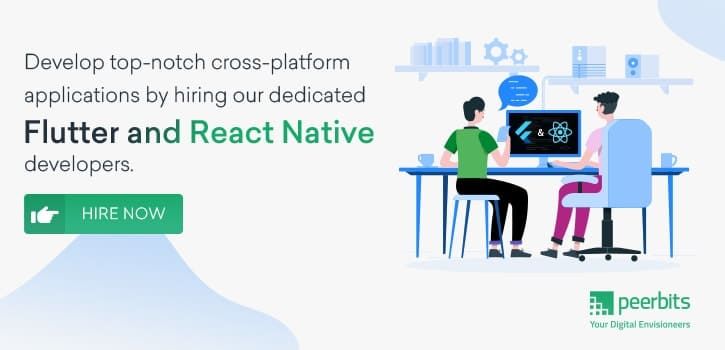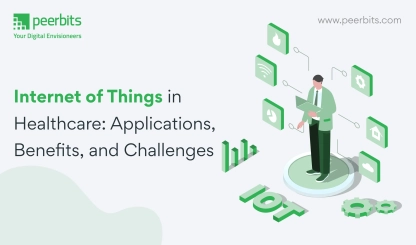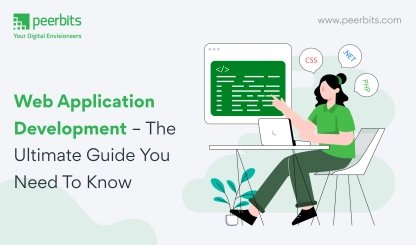Cross-platform development has transformed app creation, eliminating the need for platform-specific languages like Java or Swift. Two frameworks, React Native and Flutter, dominate this space, helping businesses build high-performance apps with a single codebase.
But which one should you choose? The answer depends on factors like project scope, business goals, and technical needs. Companies opting for React Native development services prefer React Native for its smooth web integration. Meanwhile, those exploring Flutter development services benefit from its rich UI and faster rendering.
Both frameworks offer features like hot reloading, cross-platform compatibility, and native performance, but they also have key differences. This article compares them across crucial technical aspects to help you decide the best fit for your project. Let’s dive in.
What is React Native?
React Native is an open-source mobile application framework for cross-platform mobile development which is created by Facebook. React Native which was released in March 2015, is used for both mobile as well as web applications. It enables the developers to use React Native along with other native platform capabilities.
React Native targets iOS, Android, UWP, and Web. React Native empowers the developers by allowing them to use the capability of React Native coupled with different functionalities of all the platforms. This also helps them to integrate all the desired features without any hassles.
React Native also enables developers to create user interfaces which looks exactly like native to each platform. It also allows the React Native developers to ship Android and iOS apps with just a single code base.
React Native is written with the combination of JavaScript or JSX and XML – Esque markup. React Native is built on top of JavaScript and ReactJS which makes it easier for those developers who are used to such languages.
History of React Native
- React Native began as an internal Facebook project in the summer of 2013
- React Native 1 Preview released in January 2015 at React.js Conference
- React Native got officially launched in March 2015 at F8 Conference
- Facebook declares React Native as “open for use and available on Github”
Popular apps made with React Native
- Fb Ads Manager
- Wix.com
- Tesla
- Skype
- Bloomberg

What is Flutter?
Flutter is an open-source framework which works on the language called Dart which is created by Google. Flutter is also a toolkit for software development that targets web platforms, mobile, and desktop. A developer who wants to work on Flutter must learn Dart.
Although Dart doesn’t have the popularity of JavaScript, it’s nonetheless a good programming language which is relatively easy to pick up. Generally, developers who have a background in Java and C++ can relate to Dart more than a JavaScript developer.
Flutter is also regarded as an enhanced UI toolkit which is used to develop cross-platform applications with only a single codebase. It offers Flutter developers for hire with the flexibility to build flexible and expressive UI with native performance. Furthermore, it’s contributed and supported by a team of Google developers along with the entire flutter community.
History of Flutter
- The first beta version of Flutter was released at Mobile World Congress on February 2018.
- After few months, at Google I/O, Flutter beta 2 was released on April 2018
- Then May 2018, Flutter released beta 3
- In June 2018, Flutter Preview 1 was released
- Flutter Preview 2 was released after a few months in September 2018
- Dart 2.1 was released in November 2018
- Finally, in December 2018, Flutter 1.0 was released at Google I/O
- In February 2019, Flutter 1.2 was released at Mobile World Congress
- Flutter 1.5 version was released in May 2019 at Mobile World Congress.
- In July 2019, Flutter 1.7 version was released.
- After a few months in September 2019, Flutter 1.9 was released.
- In December 2019, Flutter 1.12 was launched.
- In May 2020, Flutter 1.17 was announced.
- In August 2020, Flutter came with its 1.20 version.
- On October 1 2020, Flutter released its latest version Flutter 1.22.
Popular apps made with Flutter
- Google Ads app
- Topline app by Abbey Road Studios
- Reflectly
- Hamilton app – the official app for Broadway Musical
- Xianyu app by Alibaba

React Native vs Flutter: The ultimate comparison
We just had a look at both the frameworks in detail. Now, let’s just compare these frameworks on the basis of various criteria:
Popularity
React Native
React Native came in 2015 and since then it’s quite popular among the developers’ community. The biggest reason for its popularity is perhaps the use of JavaScript language. React Native also has a greater number of users as it’s more than a 5-year-old framework.
Flutter
Flutter is also gaining popularity among the developers. Since it came three years after the launch of React Native it has smaller community support as compared to React Native. Flutter has the support of Google, so one can say that it won’t take long to catch up with React.
And that’s exactly what’s happening, Flutter is catching up to React Native in all the parameters. The below Google trends also indicates the same.
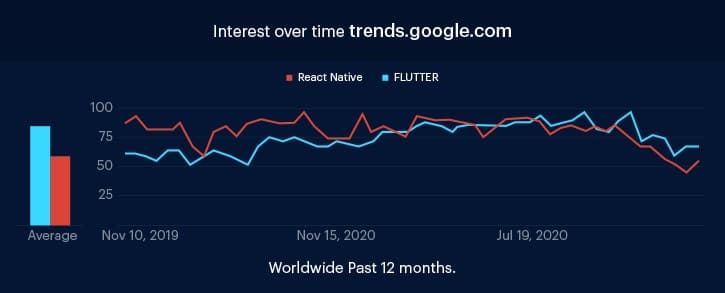
Programming language
React Native – JavaScript
JavaScript is used to write React Native with the use of React. This is a big plus for React Native as JavaScript is considered as one of the most popular programming languages in the world. This is the reason why it’s easier to find developers who can code in JavaScript. Furthermore, it’s simple for any JavaScript developer to learn React Native.
Flutter – Dart
Dart programming language which is used by Flutter was introduced by Google in 2011. However, it’s rarely used by the developers. The syntax of the Dart language is easy to understand for all the Java and JavaScript developers since it supports the majority of the object-oriented concepts. Since Dart has amazing easy-to-follow documentation available on its site, it becomes easy to get started with Dart.
Performance
React Native
The performance of React Native is lower as compared to the Flutter. The main reason behind this is the JavaScript Bridge which is responsible for establishing communication between native modules. The number of frames that got dropped in the React Native’s “hello world” app is way higher than that of Flutter.
In a few cases, it took as long as 16 milliseconds to render the program thus causing the application to stutter. Although, there are few third-party libraries such as Proguard that can help in improving the app’s performance by optimizing bytecodes.
Flutter
Flutter application performs better than React Native. It’s mainly because it doesn’t require any bridge to make communications between the native modules. This is because it already has the default availability of the native components.
As per the performance test the “hello world” app performed at 60 FPS. Also, it took less time than 16 milliseconds to render each frame. Furthermore, the number of frames that got dropped were also fewer.
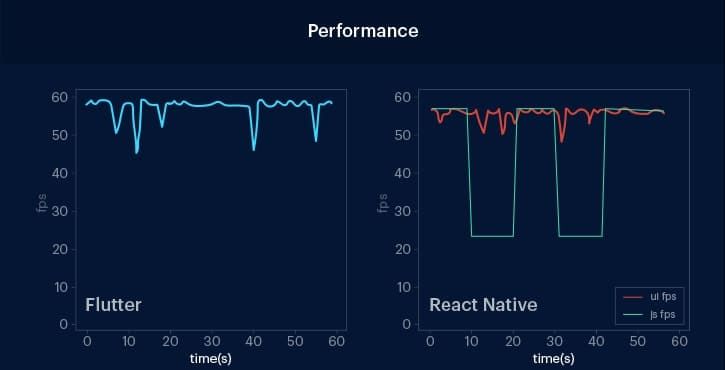
Technical Architecture
React Native
The architecture of React Native heavily depends on the JS runtime environment architecture which is also known as the JavaScript Bridge. This is a bridge between the JavaScript thread and the Native thread. According to the functionality, the JavaScript code communicates with both the Native API and the platform by using Facebook’s Flux architecture.
In Android, it bundles the JavaScriptCore within the application, whereas in iOS, it uses JavaScriptCore separately to run all the codes. This causes increase in the native functionality along with increases in the app size which ultimately results in the device lag or other performance issues.
Flutter
Flutter has a layered architecture. The hierarchy of a simple application which is built on this specific framework begins with the top-level root function which is also known as the platform-specific widgets.
Then comes the basic widgets that interacts with the rendering layers and the platform. Animation gestures are just beyond the rendering layer which transfer the API calls to the foundation of the application. It is also called Scaffold which is run by a platform-specific embedder and a C/C++ engine.
Flutter uses the Dart framework in which the majority of the components are inbuilt which makes it bigger in size and eliminates the need for a bridge to communicate with the native modules.
Dart has many frameworks such as Cupertino and Material Design which offers with all the technologies required to develop apps. The Dart framework also uses Skia C++ engine that comes with all the channels, protocols, and compositions.
Learning curve
React Native
If we talk about the learning curve of the React Native, then learning this framework is easy to learn for those developers who have earlier built applications by using JavaScript.
However, when it comes to web application development, then the developers find it difficult to learn and execute the framework. Over the years, React Native has made attempts to improve its learning curve by releasing different tutorials, extensive documents, and libraries.
Flutter
Flutter is not that difficult to learn. One might find writing codes with Dart a bit unusual, although that’s what makes it development simpler with Flutter.
To understand Flutter, beginners need to know the basics of iOS app development and Android app development. Furthermore, developers have also reported that documentation in Flutter is a lot easier and smoother as compared to the React Native.
User experience
React Native
Style design in iOS and Material Design in Android are updating every day which is making it difficult for the React Native to keep up with all updates and changes in the requirements of the native platforms.
In addition, the ready-made React Native UI kits like Ant Design, React Virgin, and Shoutem makes it even more difficult for React Native to create designs that are consistent across all the platforms.
However, there are some vital components such as Modal components, Snap indicators, Activity indicators, ScrollView fixed header, and Pagination components which significantly improves the user experience across platforms.
Flutter
Flutter leverages customized widgets, elements, and tools to provide the ultimate user experience. The Dart language of Flutter language also comes with a generational garbage collection feature which assists in creating UI frames for object codes that are often temporary.
This feature also allocates objects in a single pointer bump that prevents shutter of animation lag, UI clutter, and junk while the development process is still going on.
Testing Support
React Native
Since React Native is a JavaScript framework, there are few unit level testing frameworks which are available in JavaScript. There is a tool called Jest which can be used for snapshot testing.
Although, there’s no official support available when it comes to the integration of UI level testing. However, there are a few third-party tools such as Detox and Appium that can be used for React Native apps testing, but they are not officially supported either.
Flutter
When it comes to quality assurance and testing, then Flutter offers a cluster of testing features for testing apps at unit, integration level, and widget. You can know more testing Flutter apps from this documentation.
Flutter also a wonderful widget testing feature where a developer can create widget tests for UI testing and running them at the speed of unit tests.
Pros and Cons
Now that we have compared both React Native and Flutter in detail, let’s have a look at the pros and cons of both cross-framework platforms. These pros and cons will further help you to make the right decision.
Pros of React Native
Fast refresh with hot reloading
Hot reload enables the developers to inject new codes while the app is running. This increases the speed of development process rapidly. Moreover, the developers can also view the changes made immediately without rebuilding the app.
Freedom of choice for developers
React Native enables developers to choose exactly what solution they need both in accordance with the developer’s preferences and to the project’s requirements.
For example, if a developer needs to make a decision on how to manage the global state, they can either go with a router library or choose between TypeScript or JavaScript. They can also decide if they want to choose the custom UI library or want to write their own.
Relatively mature
React Native was released more than five years ago. In this period, the Facebook team has stabilized the API and has also focused heavily on resolving problems.
Native rendering
With React Native in place, mobile app developers can use the host platform to natively render APIs without requiring CSS markup or HTML.
Cons of React Native
Not much like Native
Similar to any of the cross-platform solution, the performance and UI experience of the React Native apps are not the same as compared to the native apps.
A cluster of abandoned packages
It’s true that React Native has a massive of libraries. However, it’s also true that many of the libraries are of either low quality or have been abandoned.
Size of apps is bigger than the native apps
All the applications that are written in React Native must run on JavaScript code. However, Android doesn’t come with this functionality by default.
So, to fix this, developers must include a library that can support the JavaScript code thus increasing the size of the app. iOS apps don’t face this problem. Although, they are still big in size as compared to the native ones.
Debugging
Chrome debugger might cause inconvenience in editing, inspecting codes, and UI elements.
Tools and Plugins
Third-party libraries which are used for successful implementation may turn out to be outdated and obsolete.
Pros of Flutter
Hot reload
With the help of a Hot reload feature,hire dedicated developers of Flutter to can make changes to the codebase and view them getting reflected immediately without losing the application state.
This feature takes a few milliseconds to show the changes. With this feature in place, the developers can fix bugs, add features, and experiment with new ideas instantly.
One codebase for two platforms
Flutter is platform agnostic which means that developers need to write just one codebase for two or more than two platforms. Furthermore, Flutter comes with its own designs and widgets which means developers can have the same app on two different platforms.
Quick shipping
Flutter provides iteration cycles which saves build time significantly since testing is only needed for the single codebase.
Seamless integration
Flutter seamlessly integrates with Swift or Objective C for iOS and with Java for Android. This integration eliminates the need for rewriting codes.
Cons of Flutter
User interface
While using Flutter, developers face problems in animation and vector graphics support. This is because it has issues in rendering plugins on time.
Continuous integration support
Flutter still lacks when it comes to the support of CI platforms like Jenkins and Travis. So, in order to get automatic testing, building, and deployment, the developers require to use and maintain custom scripts.
Operating platforms
One major con of Flutter is that it’s not compatible with the development of apps for Android Auto, tvOS, watchOS, and CarPlay.
Updates
Another major Flutter disadvantage comes in the form of updates where you can’t push patches and updates instantly into the applications until you go through the standard release processes.
Conclusion
Businesses are shifting from native apps to cross-platform development, with React Native and Flutter leading the way. React Native had the first-mover advantage, but Flutter is quickly catching up with its rich UI capabilities.
The right choice depends on your mobile app development needs, budget, and developer expertise. If you're looking for JavaScript-based solutions, you can hire React Native developers to build high-performance apps. On the other hand, if you prefer a UI-driven framework, you can hire Flutter developers for a seamless experience.
This guide should help you decide which framework suits your project best. For more expert insights, stay connected!
